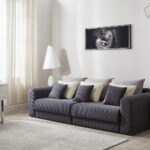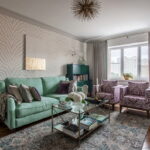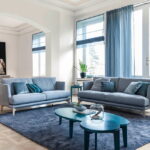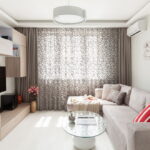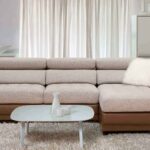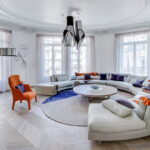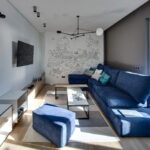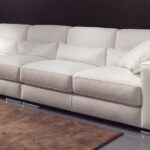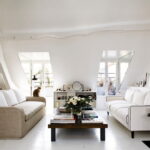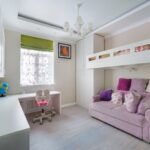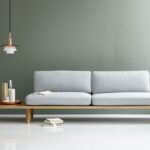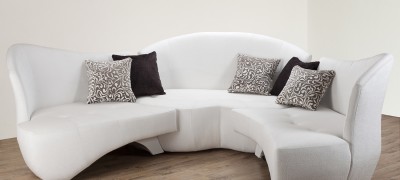Types of upholstery fabrics for sofas and their features
How to choose a fabric for a sofa so that it looks aesthetically pleasing and lasts for a long time? It is clear that you need good quality, practical material that has a presentable and up-to-date appearance. Today manufacturers offer options for covering furniture in a fairly wide range. Which one should you prefer?

What are the requirements for fabrics for upholstery upholstery
Any material used for covering pieces of furniture is selected according to a combination of certain parameters. It should be different:
- resistance to various types of mechanical stress (do not give in to stretching, do not sit down, do not wear out);
- quality of weaving (have a solid base);
- aesthetic appeal (colors and textures pleasing to the eye);
- carry pleasant tactile information (positively perceived by the organ of touch - our skin, not everyone will like a slippery, hard or sticky surface);
- environmental friendliness (especially if things with the selected casing will be installed in rooms where children and elderly people live);
- fire safety;
- airtightness (so as not to crack at the seams);
- resistance to UV rays on the surface (the latter parameter is rarely taken into account. And then, placing an armchair or a sofa in a room drenched in the summer sun, they are surprised that they, covered with spectacular tapestry or artificial leather, "turned pale": they burned out and lost their brightness) ...

Important! When choosing the optimal fabric for the upholstery of a sofa or armchairs, take into account a number of circumstances of its future "life" in new conditions.
What you need to consider:
- living (real and potential) in the apartment of young children;
- the health of family members (are there people among them who are prone to allergies);
- the presence of pets freely moving around the apartment (cats, dogs, birds released from the cage);
- the purpose of the room where the new pieces of furniture will be installed (requirements for the kitchen and living room are different);
- is it accepted to smoke indoors;
- whether things will be used daily for their intended purpose (with what frequency they sit on them, whether guests occasionally sleep on them or the owners constantly sleep on them).
Features of fabric categories
Table of accepted upholstery product categories and their respective features
|
Category |
Peculiarities |
|
0 |
Made from natural or synthetic fibers, it is a short-lived, lightweight fabric that is not durable. Inexpensive, practically does not require care procedures, but in this case, the cheapness is a dubious advantage: soon such coverage will have to be updated |
|
1 |
The characteristics of fabrics in this category are similar to those of the previous one, except that they last a little longer. |
|
2 |
Materials of the middle price segment, differ in average strength and wear resistance, are resistant to weather influences - sunlight, humidity, temperature do not harm them. Particularly difficult care is not required |
|
3 |
Materials of a complex texture, suggesting difficulties in the manufacturing process and further special care |
|
4 |
High-density sheathing that can serve for years without losing its presentable appearance |
|
5 |
Fabrics made of 100% any natural fiber, dense, resistant to wear and tear, tactilely pleasant, but requiring constant care and at a high cost |
|
6 |
Upholstery designed for regular use and loads |
|
7-8 |
Premium materials and genuine leather upholstery |
For home use, upholstery categories from 3 to 5 are usually chosen, for office use - starting from 6.

Popular fabrics for upholstery sofas and their description
What is the best upholstery for the sofa and armchairs for daily use? This is a matter of budget, tastes and personal preferences, the style of the design of the room is also taken into account, where there will be a permanent place for the purchased furniture.
Mat
Strong, dense material with textured, rough to the touch weaving, outwardly similar to burlap. Wear-resistant, practically does not wear out even at high and constant loads. Diversified in colors, unpretentious in care (clean with a vacuum cleaner and a soft sponge, using water-based products). Moderate cost.

Minuses:
- may fade when exposed to constant sunlight;
- does not like high temperatures (dry after the wet cleansing procedure in an exclusively natural way);
- not suitable for home with animals (they like to sharpen their teeth and claws on the textured surface by pulling the threads).
Cotton
Plant-based, environmentally friendly, breathable and inexpensive fabric. Dust is removed with a sponge or vacuum cleaner, cleaning - with soapy water and warm water, ironing after drying - with an iron with a temperature of no more than 100 degrees.

Disadvantages of cotton:
- easily wrinkled;
- unstable to wear, wipes;
- soon loses color and beautiful appearance.
Flock
It has interesting decorative possibilities (it depends on production technologies) - flock is often found, which is an imitation of suede, velor, chenille. There are a huge number of color options, ornaments. Pleasant to the touch (with a velvety texture), it is durable, antistatic, does not fade, and is easy to clean - an old stain can be easily removed with water and soap. Flock can be classified as a product in the middle price segment.

But the flock is not perfect either:
- abrades with constant use;
- "Mud-loving" - it becomes salted, collects small debris and dust on its surface;
- prone to absorbing odors - in kitchens and in rooms where people smoke, he has no place.
Microfiber
Innovative textiles based on cotton or polyester fabric. Highly durable, does not fade, does not tear or rub, does not absorb moisture and dirt. Resistant to fading and chemicals. Differs in a rich color palette, brightness of shades. It is easy to clean - it is easy to remove dust with a vacuum cleaner or a clothes brush. Microfiber can be washed in case of stains, but with serious dirt it is wise to contact a specialized company.

Jacquard
In appearance and texture, jacquard is similar to rayon. It is considered quite strong and durable. Furniture upholstered in jacquard is easy to fit into any interior - the material is rich in colors and prints.

The disadvantages include:
- moisture intolerance (wet cleaning, respectively, is not recommended);
- unsuitability as anti-vandal sheathing;
- the surface texture that many do not like is hard and slippery.
Opinions are opposite about the ability of jacquard to fade under the sun - apparently, it depends on the quality of the product and the conscientiousness of the manufacturer.
Scotchguard
Optimized jacquard - in the process of its production, resistant dust-, oil- and water-repellent impregnations are used that protect the fabric fibers from dirt and moisture. It is soft, but stands out for its strength, it is absolutely environmentally friendly. Printed drawings on the scotchguard do not fade or wipe out. Can be cleaned with water and an absorbent towel, dust can be removed using a vacuum cleaner, brush or sponge.

Velours
Visually attractive, tactilely pleasing, in one look it creates a feeling of coziness. Resistant to stretching. Cleaning is done with water and soap.
Disadvantages:
- dirt is difficult to remove;
- the pile wears off quickly enough;
- absorbs odors.

Boucle
Soft, elastic, wrinkle-free fabric with an interesting rough texture. Requires extremely dry cleaning.
Minuses:
- when breaking, the edges begin to "crumble";
- puffs are easily formed on the boucle;
- loose weaving of fibers helps to absorb odors, dust, moisture, dirt.

Suede leather
Suede sheathing looks expensive, elegant, stylish. It is resistant to wear and tear and has a pleasant tactile sensation. This is an expensive cladding option. Suede allows cleaning with a vacuum cleaner and wet - with soap and a sponge, but even this method of cleaning does not guarantee the elimination of strong dirt, streaks and marks may remain from them.

Chenille
The material has proven itself to be durable and resistant to wear and tear. Not prone to deformation, fading and absorption of cigarette smoke and cooking fumes. Does not cause allergic reactions. Remains invariably bright, pleasant, soft, feels warm to the touch. It is recommended to apply only dry cleaning method to chenille. There are only two disadvantages:
- easily and deeply absorbs moisture;
- afraid of the sharp claws of pets.

Tapestry
Almost natural canvas (if there is a percentage of synthetic fibers in it, then a small one). Looks sophisticated, similar to jacquard, but much stronger. Eco-friendly and hypoallergenic. Differs in many colors and patterns. Dry cleaning is recommended.

Minuses:
- burns out under UV rays;
- with active use, it is abraded;
- suffers greatly from cat and dog claws.
Leather
Prestigious and expensive premium material. Leather-upholstered pieces of furniture have a truly luxurious, solid look.It is environmentally friendly, durable when handled with care (but many even like the abrasion marks that give the products an old look, a certain shade of retro style). Requires regular cleaning of dust and periodically - lubrication with special compounds.

Disadvantages:
- fades;
- absorbs chemical and vegetable dyes, especially light;
- old dirt is extremely difficult to remove;
- claws easily damage it, strong friction;
- it is not recommended to put leather sofas and armchairs near heating devices - drying out, the skin cracks.
Important! Few people know that genuine leather does not tolerate not only high temperatures, but also sudden temperature changes. To keep it in perfect condition, use the products in a room with a stable temperature regime.
Eco leather
Inexpensive and popular imitation of natural material. The name hints at environmental friendliness. Moisture-resistant, hygienic, not impregnated with dubious aromas, does not wear off, differs in the "friendliness" of the texture - not cool, like real skin. It is recommended to treat with water-repellent agents for a natural analogue, but in cases of severe contamination, entrust the cleaning to specialists.

Minuses:
- may crack over time;
- fire hazardous;
- adheres to the human body.
Important! It is advisable not to skimp on the quality of the furniture itself and to select products with a strong frame, high-quality fillers and reliable fittings. Even if the furniture upholstery breaks down over time, quality products can be sheathed with new fabric. But if the sofa is also squeezed, and the chair is loosened, they will have to be sent to a landfill.
Features of the choice of fabric for upholstered furniture if there is a cat in the house
What vandal-resistant fabric is better to choose for the upholstery of the sofa if a cat lives in the apartment or if you plan to purchase a pet? It is required to stop in the choice of the casing, called anti-vandal (otherwise - "anti-claw"). But claw hooks are not the only difficulty awaiting the owners of seals - it should be borne in mind that the animal can leave spots on the sofa surface and will certainly leave tufts of fur (if it is not a hairless sphinx).
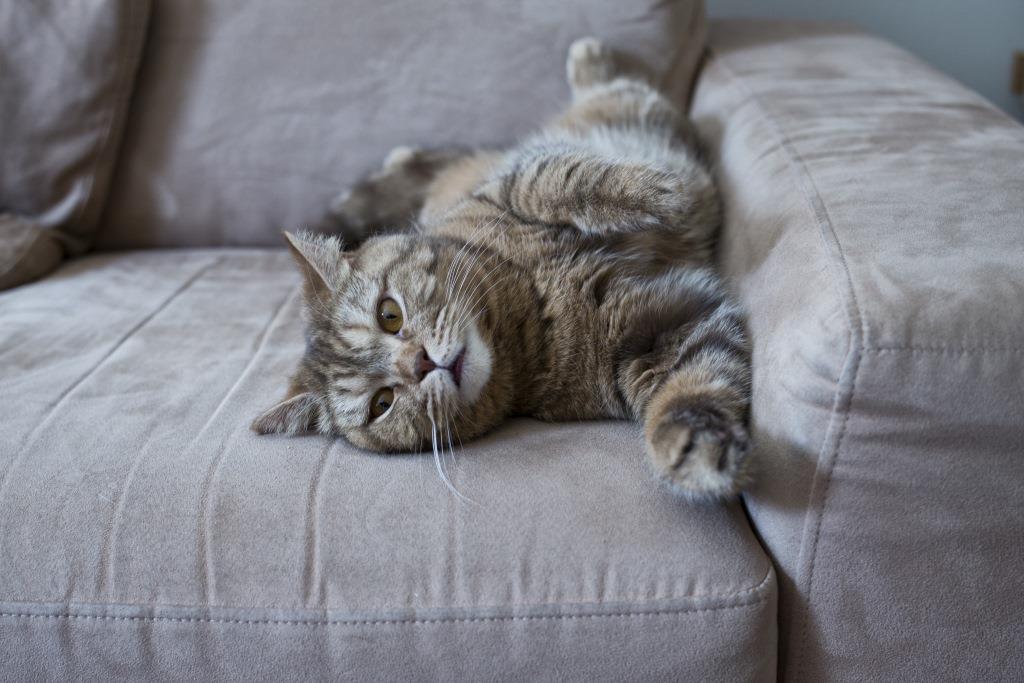
Are there ways to preserve upholstered furniture? Yes, they exist, but they work with dubious success:
- Teaching a cat to a scratching post can really save sofas, ottomans, armchairs - provided that the animal has been taught the skill of sharpening its claws in a certain place. Not all animals work well.
- The use of covers that save the casing from claws is far from satisfactory for everyone - oversized things, constantly covered with peeled covers, look extremely unaesthetic. And why buy a thing, upholstered with beautiful fabric, if it is still not visible?
- Attempts to teach a cat not to visit items of upholstered furniture, fans of these animals generally consider the strangest idea - many people love to communicate with them there, sleep in an embrace with warm and fluffy "younger members of the family." And the animals themselves willingly choose soft seats, armrests, mattresses for daytime sleep.
- Chemicals that scare animals away from sofas and armchairs are also not the best solution. Their aromas can irritate the mucous membranes of the hosts, cause allergies, spoil the coatings (especially if these compositions are from unknown manufacturers - one thing is written on the bottle, and something similar to dichlorvos is poured into it).

The best solution is the choice of anti-vandal upholstery textiles. It:
- Relax is an artificial cotton-based canvas with polyester additives and an isoprene coating that looks like leather. Isoprene carbon fiber perfectly protects the pile. Relax perfectly washes (even old stains and stubborn dirt can be removed with a soap solution), is not prone to deformation, and is able to withstand high loads. Thanks to its innovative composition, relax is not at all afraid of cat scratches - its structure does not suffer serious damage from them;
- Teflon coated flock is an innovative new material on the market. It differs not only in all the advantages of a conventional flock, but also in its high resistance to scratching. And it is easy to clean it from stains with soapy water;
- Microfiber is created from a dense weave of threads, and additionally protected by a Teflon impregnation layer, it becomes an excellent anti-vandal coating. Despite the relative thinness, this microfiber upholstery is strong, practical and durable, easy to clean, and in the form of covers is easy to wash. After drying, the “suede” surface texture is restored with a soft brush;
- Faux suede is created on a fabric basis, and its pile is made of polyester. Artificial fibers give the material strength and reliability in operation. To create the “anti-claw” coating, it is reinforced with Teflon impregnation, which increases resistance to scratches and cuts, as well as guarantees easy removal of dirt. It is required to clean artificial suede, taking into account the manufacturer's recommendations.

As for cat hair, which sticks to almost any upholstery fabric, its amount can be significantly reduced by periodically combing out the animal and collecting hairs and shreds with special adhesive rollers, which are sold in any supermarket. A vacuum cleaner with a turbo nozzle will help to remove a large amount of wool, and a small one can be easily removed by putting on a rubber glove moistened with water.

If the cat sleeps exclusively in a certain place on the sofa or strictly in one of the chairs, you can put a bedding on this place, creating a "mattress" for the animal. Most of the hair will remain on it.
Regardless of the type of furniture upholstery, any fabric or non-woven covering must be properly and promptly looked after. In this case, it will serve for a long time, retaining its attractive appearance and its best qualities.

Video: how to choose an upholstery fabric for a sofa





